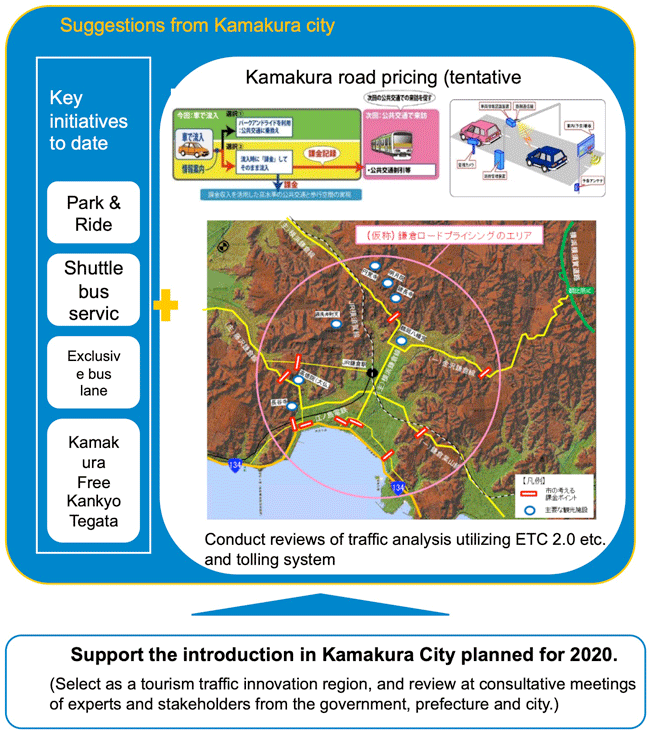Smart Use of Network
Pinpoint / Additional lanes
In order to realize economic growth by improving productivity, we promote "Smart Use" initiatives that aim to maximize the functionality of the road network overall by improving the operation of, and making small-scale alterations to, existing roads.
Background / Data
-Total losses due to traffic congestion are approx. 5 billion person-hours per year, which equates to the manpower of approx. 2.8 million people.
Total time loss due to traffic congestion per person per year is approx. 40 hours, which is equivalent to approx. 40% of total travel time (approx. 100 hours).

-Loss due to traffic congestion in major European cities is approx. 20% of total travel time.
-Traffic demand is concentrated on specific times of day, seasons, and
○In order to mitigate congestion and enhance functionality of expressways quickly at low cost, execute pinpoint measures using big data from ETC 2.0 etc.
・Higashi-Meihan Expressway: measures are already implemented at 9 locations including near Yokkaichi.
・Kan-etsu Expressway: Operations are ongoing at 10 locations including near Takasaka SA.
○Utilizing ETC 2.0 and AI cameras, etc., take effective pinpoint measures while developing more sophisticated methods to identify causes of traffic congestion.
○Enhance major highways to complement existing network of expressways in city areas that are clear bottlenecks in traffic capacity.
"Smart investment" based on big data analysis
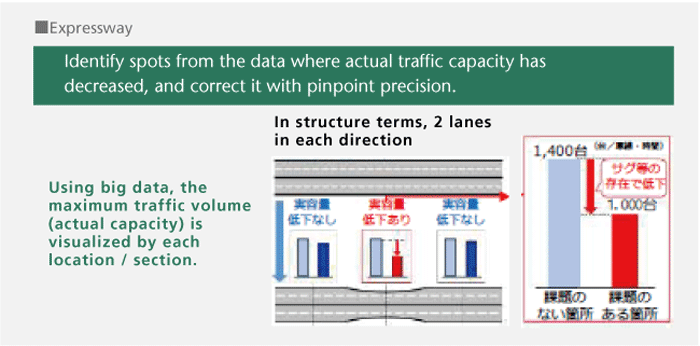
Tokyo Metropolitan Expressway Central Circular Route (inner loop/outer loop) between Itabashi Jct. and Kumanocho Jct. was widened from 3 to 4 lanes and reopened.
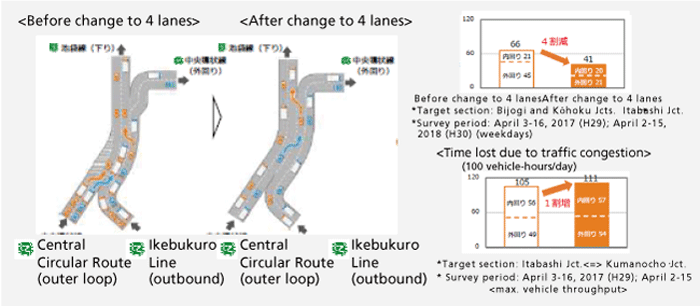
Promoting public-private initiatives to mitigate traffic congestion
Promoting public-private initiatives to mitigate traffic congestion, such as identifying congestion spots from the viewpoint of road users including buses, and mitigation measures taken by developers of large-scale facilities that are causes of congestion.
Background / Data
-Congestion mitigation committees across the nation identified approx. 9,000 major congestion points based on the latest traffic data (as of April, 2018).
-Over 10% of the major congestion points (approx. 1,200) are at the locations of commercial facilities such as large-scale retail stores
-Nationally, roadworks on roads directly managed by MLIT are down by approx. 60%, but the downward trend seems in recent years to be at an end (approx. 201 hrs/km-year (FY2002) →approx. 82 hrs/km-year (FY2017))
○Enhance collaboration between congestion mitigation committeesand bus/truck etc. user groups, identify congestion spots from the viewpoint of users, and swiftly promote effective initiatives nationwide.
○Introduce stricter review process for granting road-facing permission, such as requiring large-scale facility developers to perform traffic assessments, etc.
Flow of congestion mitigation
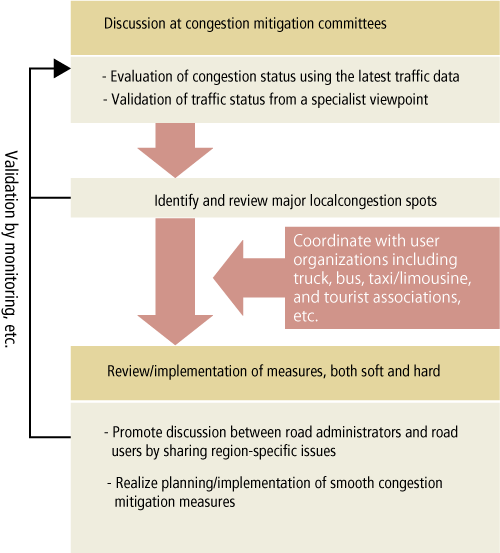
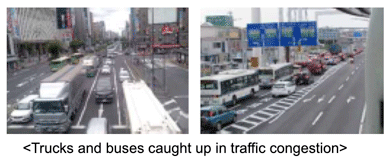
ICT and AI techonology
To integrate analysis technology with various sensors and AI, as well as ETC 2.0, to enhance traffic management considering spatiotemporal variation.
Background / Data
-Roadside ETC 2.0 units are already installed at locations that take into account major congestion spots, with the 3 NEXCO companies, Shuto Expressway, Hanshin Expressway, Honshu-Shikoku Bridge Expressway, and directly-managed national highways. The units collect probe data such as vehicle locations.
-Onboard ETC 2.0 devices are installed in approx. 2.87 million vehicles (as of June 2018)
-Introduction of the quasi-zenith satellite system (4 satellites from 2018) compensates the GPS system and enables highly accurate location measurement (the accuracy was improved from over 10m to over 10cm).
-In Singapore, London, etc., to mitigate central-area congestion, an area-pricing system manages traffic demand by charging vehicles entering the central urban areas.
○Promote the introduction of regional congestion mitigation policies including tolls, using innovative technologies including ICT, AI etc. in tourist areas to adjust traffic demand.
○In Kamakura city, which suffers heavy traffic congestion mainly on weekends and holidays, we support the city's initiative that aims to introduce a road pricing system in 2020 based on reviews of traffic analysis and toll structures utilizing ETC 2.0, etc.
○Study the use of AI cameras, ETC 2.0 etc. to replace a 5-yearly traffic survey with a new road traffic survey system based on constant measurement.
Area congestion mitigation measures using ICT/AI
